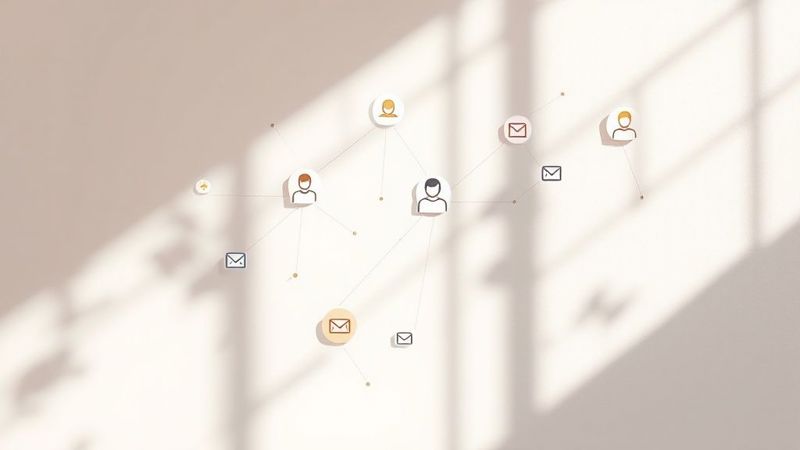The Real Power Behind Dynamic Content Emails

Dynamic content email marketing goes beyond simply adding a subscriber's name. It's about crafting a truly personalized experience that resonates with each individual. This means the email's content adapts based on the subscriber's unique traits and behaviors.
Imagine a sale on winter coats. With dynamic content, subscribers in warmer climates might see swimwear instead. This ensures relevance and boosts engagement. This personalized approach is driving the growing popularity of dynamic content in email marketing.
As of 2024, 68% of email marketing professionals consider dynamic content personalization crucial for effective campaigns. This underscores the importance of engaging subscribers with relevant content. Find more detailed statistics here: Shopify Email Marketing Statistics.
How Dynamic Content Drives Engagement
Dynamic content boosts engagement by presenting timely and relevant information. This tailored experience creates a personal connection, making recipients more likely to interact with your emails.
Dynamic content can also anticipate subscriber needs. For instance, if a customer recently browsed running shoes on your website, a follow-up email could dynamically display running apparel and accessories. This proactive approach encourages further exploration and increases purchase likelihood. You might be interested in: How to Master Dynamic Email Images.
Key Elements of Dynamic Emails
Several dynamic elements enhance email engagement:
- Personalized Product Recommendations: Suggest items based on past purchases, browsing history, or stated preferences.
- Geo-Targeted Offers: Tailor promotions and content based on location.
- Timely Content Updates: Display real-time information, such as shipping updates or event reminders.
- Customized Calls to Action: Guide subscribers towards actions aligned with their interests and customer journey stage.
Implementing Dynamic Content Effectively
Even small teams can implement dynamic content efficiently. Many email marketing platforms offer user-friendly tools and templates for creating dynamic emails. This means you don't need extensive coding knowledge to begin.
Focusing on a few key dynamic elements initially allows for a gradual implementation. Starting small lets you test and refine your strategy before scaling up. This iterative approach ensures your dynamic content is optimized for maximum impact.
Beyond Open Rates: The True Benefits of Dynamic Content

While open rates offer a glimpse into email performance, dynamic content in email marketing offers much more. It goes beyond simple opens and clicks to focus on tangible results. Think of it as a way to personalize the entire customer journey, from the first email to long-term loyalty.
For instance, dynamic content can transform conversion pathways. Instead of generic product emails, you can tailor recommendations based on individual browsing history or past purchases. This targeted approach presents subscribers with products they actually want, increasing the likelihood of a purchase. Dynamic content also strengthens customer relationships. By providing relevant and timely information, you build trust and foster repeat business.
Reducing List Fatigue and Increasing Retention
One often overlooked benefit of dynamic content is its ability to combat list fatigue. When subscribers receive irrelevant emails, they unsubscribe. Dynamic content helps prevent this by ensuring every communication provides real value. This leads to higher retention rates and a more engaged audience.
This means you're not just sending emails; you're building connections. By offering content that resonates with individual needs and preferences, you show subscribers you value them. This creates a sense of connection and encourages continued engagement with your brand. Dynamic content also streamlines your email marketing efforts. Automating personalization through a single, adaptable template saves time and resources while maintaining consistency. For more inspiration, check out these Best Dynamic Email Content Examples.
Accelerating Decision-Making with Targeted Messaging
Dynamic email also speeds up decision-making. Imagine a customer considering software. A dynamic email can address their specific concerns based on their website activity. This targeted messaging helps eliminate obstacles and encourages a purchase.
This personalized approach works in both B2B and B2C settings. In B2B, dynamic content can personalize case studies and testimonials by industry or company size. In B2C, it might offer personalized style guides or product recommendations based on past purchases. By meeting subscribers where they are in their journey, dynamic content simplifies the path to purchase. It removes friction, clarifies complex information, and empowers informed decisions.
To illustrate the differences between traditional static email and dynamic email, let's look at a comparison:
Dynamic vs. Static Email Content Comparison
This table compares traditional static email approaches with dynamic content strategies across key performance metrics and implementation factors.
| Metric/Factor | Static Email Content | Dynamic Email Content |
|---|---|---|
| Personalization | Limited to basic name/company | Highly personalized based on individual data |
| Relevance | Often generic and irrelevant to many recipients | Highly relevant to each recipient's needs and interests |
| Engagement | Lower open, click-through, and conversion rates | Higher open, click-through, and conversion rates |
| Customer Retention | Contributes to list fatigue and unsubscribes | Improves retention and reduces list churn |
| Conversion Rates | Generally lower due to lack of personalization | Higher due to targeted messaging and offers |
| Production Time | Can be quicker initially, but less efficient long-term | Requires more initial setup but automates personalization |
As you can see, while static email content may be simpler to create initially, dynamic email offers significant advantages in terms of engagement, conversions, and customer retention. By leveraging the power of personalization, businesses can create more effective email campaigns that resonate with their audience and drive better results.
Dynamic Content Types That Actually Drive Results

Let's dive into some dynamic email content strategies that are making a real impact. We'll explore real-world examples to see how techniques like location-based offers and behavior-triggered recommendations are transforming email campaigns.
Location-Based Offers
Imagine a retailer promoting umbrellas. Using geo-targeting, subscribers in rainy areas receive umbrella promotions, while those in sunny locations get sunscreen offers. This ensures relevance and increases the chance of a purchase.
Location-based offers tap into immediate needs. This creates a timely and valuable experience, particularly effective for businesses with physical stores or location-specific services.
Behavior-Triggered Recommendations
Dynamic content also fuels behavior-triggered emails. Think about abandoned online shopping carts. An automated email can dynamically display the left-behind items, along with a reminder or incentive to complete the purchase.
This proactive approach re-engages potential customers and recovers lost sales. Suggesting related products based on browsing history can also significantly boost conversion rates.
Purchase History Promotions
Using purchase history allows for truly personalized promotions. A coffee company, for example, could send a discount for a customer's favorite blend just before they typically run out.
This strengthens customer loyalty and encourages repeat business. It shows you understand customer preferences, building a more meaningful connection. Purchase history can also introduce complementary products or services.
Engagement-Level Adaptations
Engagement-based dynamic content tailors emails based on past interactions. Highly engaged subscribers might receive exclusive content or early access to promotions. Less engaged subscribers might get a re-engagement campaign or a simpler email with key updates.
This fosters a sense of community and rewards loyalty. It ensures you're delivering the right content to the right audience, maximizing engagement and minimizing list fatigue.
By combining these dynamic content types, brands create deeply personalized email experiences. This goes beyond generic messaging to connect with each subscriber individually, improving open rates, click-through rates, and ultimately, conversions. A travel company, for instance, could combine location data with purchase history to suggest relevant travel packages. This creates a highly personalized and valuable experience.
Crafting Your Dynamic Content Strategy

Creating a successful dynamic content email marketing strategy requires careful planning and execution. It's about understanding your audience, finding ways to personalize their experience, and building a strategy that works for your team. Let's explore the key steps.
Auditing Your Current Email Program
Start by taking a close look at your current email marketing performance. Where are you using generic content that could be more personalized? Analyzing open rates, click-through rates, and conversion data for different segments can reveal valuable insights.
Also, think about how you gather and use subscriber data. Are you using tools like preference centers or behavioral tracking? This initial review helps you understand what's working, what's not, and where to focus your efforts. For more tips on using customer data, check out our guide: How to Use Customer Data to Drive Email Marketing Success.
Identifying Personalization Opportunities
Once you have a good grasp of your current email program, look for ways to personalize the experience. Go beyond simple demographics and consider behavior patterns and engagement signals.
For example, instead of segmenting just by age, segment based on past purchases or website activity. This allows you to deliver relevant content and offers, increasing engagement and conversions. Think about how you collect first-party data. Preference centers let subscribers choose what interests them. Progressive profiling gradually collects more data over time. Behavioral tracking analyzes website activity and email clicks. These tools help build richer subscriber profiles for better personalization.
Developing a Sustainable Implementation Plan
Build a plan that's manageable and sustainable for your team. Begin with a few key dynamic elements, such as personalized product recommendations or location-based offers. This allows you to test and refine your approach before expanding it further.
A phased approach ensures your dynamic content strategy is both effective and sustainable. Use key performance indicators (KPIs), like conversion rates and customer lifetime value, to measure your success. This data-driven approach enables ongoing improvement and optimization.
To help guide your implementation, we've created a roadmap outlining the key phases and activities involved in building a dynamic content strategy.
The following table provides a step-by-step guide to implementing dynamic content in your email marketing, outlining key activities and expected outcomes for each phase.
Dynamic Content Implementation Roadmap
A step-by-step guide showing the phases of implementing dynamic content in email marketing with key activities for each stage
| Implementation Phase | Key Activities | Resources Required | Expected Outcomes |
|---|---|---|---|
| Assessment | Analyze current email performance, data collection methods, and segmentation strategies. | Email marketing platform data, analytics tools. | Identification of areas for improvement and potential personalization opportunities. |
| Planning | Define target segments, brainstorm personalized content ideas, and select dynamic elements. | Marketing team collaboration, customer data analysis. | A clear roadmap for dynamic content creation and implementation. |
| Implementation | Set up dynamic content rules within your chosen email marketing platform, integrate data sources, and test email variations using A/B testing tools. | Email marketing platform, data integration tools, testing resources. | Personalized emails delivered to targeted segments. |
| Optimization | Monitor key metrics, analyze performance, and adjust dynamic content rules based on results. | Analytics dashboards, A/B testing tools. | Improved email engagement, conversion rates, and ROI. |
This roadmap provides a framework for building a robust dynamic content strategy, ensuring each phase is carefully considered and executed for optimal results. By following these steps, you'll create personalized email experiences that strengthen customer relationships and drive measurable results.
Making Dynamic Content Work (Without Technical Headaches)
Concerned about the technical complexities of dynamic email content? This section simplifies the process, offering clear guidance for marketers of all technical skill levels. We'll explore how to create personalized emails without needing a dedicated development team.
Choosing the Right Email Service Provider
Your email service provider (ESP) is essential for implementing dynamic content. Some ESPs provide more user-friendly dynamic content features than others. Look for platforms with intuitive visual editors and pre-built dynamic content blocks. Many popular ESPs, like Mailchimp and Klaviyo, offer robust dynamic content features, allowing you to personalize emails without complex coding. These platforms provide tools to easily segment your audience and tailor content based on various criteria. OKZest is compatible with 99% of ESPs.
Low-Code Approaches to Personalization
You don't need coding expertise to personalize emails. Many ESPs offer low-code or no-code solutions. These platforms utilize visual editors and drag-and-drop interfaces, making it easy to create dynamic content blocks and personalize elements such as images, text, and calls to action.
For example, you can create a single email template and use conditional logic to display different product recommendations based on past purchases. This saves you time and effort by eliminating the need for multiple email versions. OKZest enhances this further by enabling personalized images within these dynamic emails.
Using HTML and CSS for Dynamic Elements
For those familiar with basic HTML and CSS, some ESPs allow for more advanced customization. You can use these languages to precisely control the appearance and behavior of your dynamic content. For instance, you can use CSS to change the color of a call-to-action button based on the subscriber's location.
This approach provides greater flexibility, letting you tailor the visual presentation of your dynamic emails for a truly branded experience. However, even without these coding skills, you can still achieve significant personalization using pre-built dynamic blocks within your ESP.
API Integrations for Seamless Data Flow
Connecting your email platform to your existing customer data is essential for effective personalization. API integrations enable seamless data flow between your email platform and other systems, such as your CRM or e-commerce platform.
This allows you to automatically populate dynamic content with real-time information from your databases. For example, you could personalize an email with loyalty program points or recent purchase details pulled directly from your CRM. This ensures your dynamic content is always current and relevant. OKZest provides smart API integrations to further simplify this process, connecting your dynamic images with live data feeds.
Mobile Responsiveness and Load Time Optimization
Dynamic content should function flawlessly on all devices. Prioritize mobile responsiveness to ensure your personalized emails display correctly on smartphones and tablets.
Additionally, optimize image sizes and minimize code to ensure fast load times. Slow-loading emails can frustrate recipients and decrease engagement. Test your dynamic emails on various devices and email clients to ensure optimal performance.
Fallback Strategies for Missing Data
Sometimes, you might lack personalization data for a particular subscriber. Having fallback strategies is crucial. For example, if you're personalizing a greeting with the subscriber's name, but that data is missing, use a generic greeting like "Hello valued customer" as a fallback.
This prevents awkward blank spaces or errors in your emails, ensuring a positive experience for every recipient. OKZest simplifies this process by providing default values and fallback text options for your dynamic image content. This maintains a seamless and professional look, even with incomplete personalization data.
Measuring Success and Optimizing Performance
Measuring the success of your dynamic content email marketing campaigns goes beyond simple open and click-through rates. It's about understanding how personalization affects the entire customer journey, from initial engagement to building long-term loyalty.
Key Metrics for Dynamic Content
To truly gauge the performance of your dynamic content, track specific metrics that show the real impact of personalization. Focus on data that reflects business outcomes, not just surface-level metrics.
Segment-Specific Engagement: Analyze open and click-through rates for each segment. This helps you see which personalized content resonates with different audiences. For example, are new customers engaging more with welcome offers than product recommendations? This detailed approach reveals what truly connects.
Incremental Conversion Lift: Compare the conversion rates of your dynamic emails against static email campaigns. This shows how personalization directly affects your bottom line. A higher conversion rate means tailored content encourages the actions you want customers to take.
Customer Journey Acceleration: Analyze how quickly subscribers move through the sales funnel after receiving dynamic content. Does personalization speed up decisions? By how much? This helps justify the value of dynamic content email marketing for lead nurturing and sales cycle efficiency.
By focusing on these metrics, you get a clearer picture of your dynamic content strategy’s true impact. This data-driven approach helps you make informed decisions about optimizing your campaigns. Learn more in our article about Email Marketing KPIs.
Testing and Refinement
Effective dynamic content requires continuous optimization. This means using robust testing and iteratively refining your approach based on performance data.
Control Group Establishment: A/B test your dynamic emails against static versions to measure the impact of personalization. This requires a control group that receives generic content, allowing for a direct comparison.
Performance Attribution Modeling: Figure out which dynamic elements contribute most to your success. Is it personalized product recommendations, location-based offers, or something else? Knowing this helps you prioritize and refine your content strategy.
Iterative Optimization: Use performance data to continually refine your segmentation, content rules, and targeting. Testing different dynamic content types and combinations is key. For example, if location-based offers are underperforming, try different offers or adjust your location targeting.
Troubleshooting and Advanced Optimization
Even with careful planning, dynamic content can sometimes miss the mark. Understanding common issues and having troubleshooting strategies is crucial.
Data Quality: Inaccurate or incomplete data can hinder personalization. Make sure your data is clean, current, and properly integrated with your email platform. OKZest helps by offering default image content when personalized data is missing, ensuring a smooth experience.
Over-Personalization: Too much personalization can feel intrusive. Balance relevance with respecting subscriber privacy. Carefully consider which data points to use and how to present them.
Technical Issues: Dynamic content relies on technical functionality. Ensure your email platform and integrations are working correctly. OKZest simplifies the technical side of dynamic content with easy-to-use no-code solutions and API integrations.
By addressing these challenges and continually refining your approach, you can improve your results. Dynamic content isn’t a one-time setup; it’s an ongoing process of learning, testing, and optimization.
Ready to enhance your email marketing with personalized images? Visit OKZest and discover how easy it is to create dynamic visuals that boost engagement and drive results.